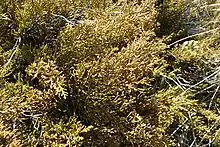| Lepidothamnus laxifolius | |
|---|---|
 | |
| Scientific classification | |
| Kingdom: | Plantae |
| Clade: | Tracheophytes |
| Clade: | Gymnospermae |
| Division: | Pinophyta |
| Class: | Pinopsida |
| Order: | Araucariales |
| Family: | Podocarpaceae |
| Genus: | Lepidothamnus |
| Species: | L. laxifolius |
| Binomial name | |
| Lepidothamnus laxifolius Hook.f. Quinn. | |
Lepidothamnus laxifolius, commonly known as the pygmy pine or mountain rimu, is a species of conifer in the family Podocarpaceae. It is endemic to New Zealand, where it is found in the North Island, the South Island and on Stewart Island.
Distribution
Lepidothamnus laxifolius is a high alpine specialist found in high-altitude bog communities and in scrub, often in association with Halocarpus bidwillii and Podocarpus nivalis. Example locations include Tongariro National Park and Arthur's Pass. On Stewart Island it is found in lowland as well as in montane areas.
Description
It has a scrambling prostrate habit and plants as little as 8 cm in height have been observed in fruit. Branches may be up to 5 mm in diameter and up to 1 metre long. Its cones are red and fleshy, and borne terminally on the horizontal branches.[2] The seed is dark brown on red fleshy scales.[3] It is believed to be the smallest conifer in the world and is rarely bigger than a small low-growing shrub.[4]
Taxonomy
The genus Lepidothamnus was once part of Dacrydium in the classification by Bentham and Hooker in 1880. However, current taxonomy separates it as a distinct genus with three species, one endemic to southern Chile and the other two in New Zealand. All three species have a distinctive cone morphology not shared with other podocarps with its erect ovule, as well as the absence of resin ducts in the leaves. These three species also synthesise cupressuflavone as their major biflavonoid – a feature not found in other podocarps.[5] They have narrow, linear spreading juvenile leaves that gradually change into more strongly keeled and appressed scales. Female cones are borne singly and at the ends of branches and each has 3–5 bracts with very elongated bases. Each fertile bracts supports an erect ovule in its axil and this ovule remains erect throughout its development.
References
- ↑ Thomas, P. (2013). "Lepidothamnus laxifolius". IUCN Red List of Threatened Species. 2013: e.T42481A2982106. doi:10.2305/IUCN.UK.2013-1.RLTS.T42481A2982106.en. Retrieved 15 November 2021.
- ↑ Dallimore, William, Albert Bruce Jackson, and S.G. Harrison. 1967. A Handbook of Coniferae and Ginkgoaceae, 4th ed. New York: St. Martin's Press. xix, 729 p.
- ↑ Eagle, Audrey (2008). Eagle's complete trees and shrubs of New Zealand volume one. Wellington: Te Papa Press. p. 26. ISBN 9780909010089.
- ↑ Dobson Nature Walk: the Natural History of an Alpine Pass, New Zealand Department of Conservation, 2006, ISBN 0-478-14068-1
- ↑ Quinn, C J (1982). "Taxonomy of Dacrydium Sol. Ex Lamb. Emend. De Laub. (Podocarpaceae)". Australian Journal of Botany. 30 (3): 311. doi:10.1071/BT9820311. ISSN 0067-1924 – via CSIRO.
